AMD Zen 4 Ryzen 9 7950X and Ryzen 5 7600X Review: Retaking The High-End
by Ryan Smith & Gavin Bonshor on September 26, 2022 9:00 AM ESTClosing Thoughts
While AMD has made significant strides with Zen 4 over the previous Zen 3 and Zen 2 microarchitectures, it's time to translate these improvements into actual performance. First of all, our Ryzen 9 7950X boosted up 5.74 GHz on a single-core, which is very impressive. Although this frequency is primarily designed to increase performance throughput on single-threaded applications, the reality is that under sustained load, depending on the aggressiveness of the cooling, is more around 5.4 GHz.
AMD's claim of an uplift of around 13% in IPC performance over Ryzen 5000 seems right on the money, and an overall improvement of 29% in single-threaded performance. Even this is still a marked improvement over AMD's Ryzen 5000 processors, which benefited from a maximum single-core boost of around 5.05 GHz, taken from our Ryzen 9 5950X and Zen 3 deep dive. In our SPEC2017 suite, we saw similar gains in single-threaded performance across various workloads.
It is in multi-threaded performance where AMD's Zen 4 based Ryzen 7950X excels. In some workloads, we saw up to an increase of 38% in multi-threaded performance in SPEC2017 nT, with others floating around the 30% mark when compared directly to the Ryzen 9 5950X (Zen 3), which is what AMD is claiming.
For the following conclusion analysis, we do test at JEDEC settings, but it's apparent that using AMD EXPO memory profiles, such as DDR5-6000, will ultimately lead to slightly higher performance in difference scenarios. If you would like us to investigate memory scaling on the Zen 4 core at some point in the future, please let us know in the comments.
A Quick Note on Temperatures: Zen 4 is Hot, But it's a Design Choice
When compared directly to the previous generation (Zen 3), AMD's Ryzen 7000 processors run quite hot; in fact in our testing, it was rare if our chips didn't hit their respective TJ Max of 95°C. The 95°C mark is where AMD has designed Ryzen 7000 to hover around, which maximizes processor performance up to this point, with frequencies scaling back with Precision Boost Overdrive.
Although AMD has said explicitly that 95°C is not the limitation, users can override this to a maximum of 115°C when manually overclocking. We feel that the higher all-core frequencies under maximum load, 95°C is a sufficient level of heat for what is on offer when it comes to overall performance. This might disgruntle users looking to use Ryzen 7000 in more tight spaces, such as small form factor systems where cooling performance is somewhat limited. Still, users can always use the incoming ECO Mode to make things more manageable (more on that down the page).
Ryzen 7000: Adding AVX-512 Support (Double Pumping With 256-bit Channels)
As we can see in our 3DPM v2.1 AVX workload test, due to AMD's implementation of its 256-bit data path, which AMD claims is to prevent thermal and frequency compromises in peak performance, the Ryzen 9 7950X and Ryzen 5 7600X both trounce the competition in AVX workloads.
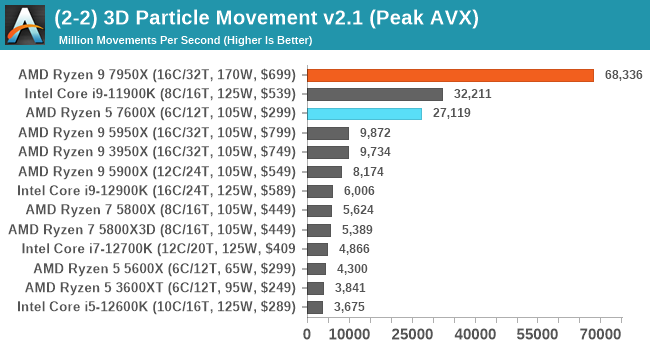
Although the use case of AVX-512 is limited to specific applications such as emulation, Ryzen 7000 and Zen 4 give users looking to utilize AVX and AVX-512 a route to do so through the desktop platforms.
AMD Ryzen 7950X: Breaking 38K in CineBench R23, New World Records
In the past, AMD has broadly used CineBench as a measure of its performance; higher core and thread counts are typically favored by rendering workloads, so it's understandable why. AMD sent us a PR around its performance with the Ryzen 9 7950X breaking 48k in CineBench R23 nT at 6.45 GHz all-core using liquid nitrogen cooling. While this is impressive, and ultimately a new world record (someone will break it quickly), this isn't entirely relevant to the masses, and we're focusing on real-world everyday performance.
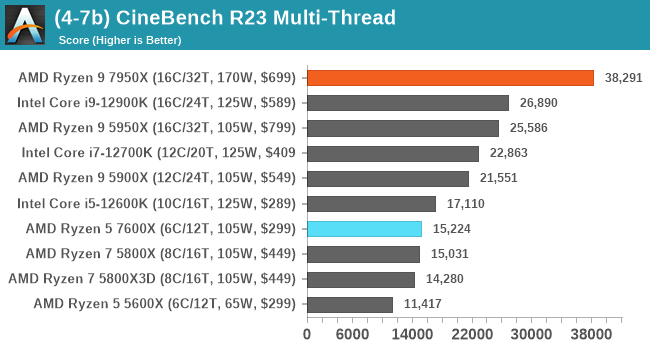
Looking at multi-threaded performance in CineBench R23, the AMD Ryzen 7950X achieved over 38K, which is undoubtedly impressive. Compared directly to Intel's Core i9-12900K, AMD is leading Intel here by around 42%, which is fantastic if you're looking for a desktop processor that's good at everything but excels in rendering workloads. By contrast, as the Ryzen 5 7600X is a 6C/12T chip, rendering performance isn't as impressive, but it's compatible with the Ryzen 7 5800X (8C/16T), which it competes with on a pretty consistent basis as per our testing for this review. That is impressive as it shows that six Zen 4 cores are roughly equal to eight Zen 3 cores.
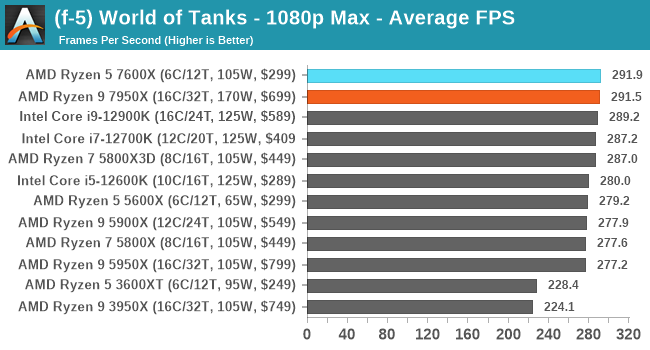
Focusing our attention on gaming performance and the improvements we are seeing in our current yet soon-to-be updated CPU gaming suite aren't as fruitful as in compute-related tasks. While the AMD Ryzen 9 7950X and Ryzen 5 7600X are competitive against other CPUs such as the Core i9-12900K in the gaming sphere, there are certainly trade-offs to consider.
Looking at our result in World of Tanks using our soon-to-be-retired NVIDIA GeForce RTX 2080ti, the Ryzen 5 7600X sits at the top at 1080p Max settings regarding average frame rates. This does show that AMD's Zen 4 core is undoubtedly powerful for gaming, even at the lower end of the product stack, such as the Ryzen 5. Ultimately, the Ryzen 7000 series is trading blows with Intel's 12th Gen Core (Alder Lake) processors across many games at various settings.
Interestingly, the previous generation Ryzen 7 5800X3D with 96 MB of 3D V-Cache is also in the mix at the top end of the gaming spectrum, and despite AMD announcing that it will be releasing a Ryzen 7000-based SKU with its 3D V-Cache packaging technology, we're unfortunately going to have to wait until next year at the earliest for this. It should make for some interesting gaming results, depending on which Ryzen series it looks to capitalize on. It will be even more interesting to see how Intel, if it can, responds in the manner that the Ryzen 7 5800X3D impacted in framerates.
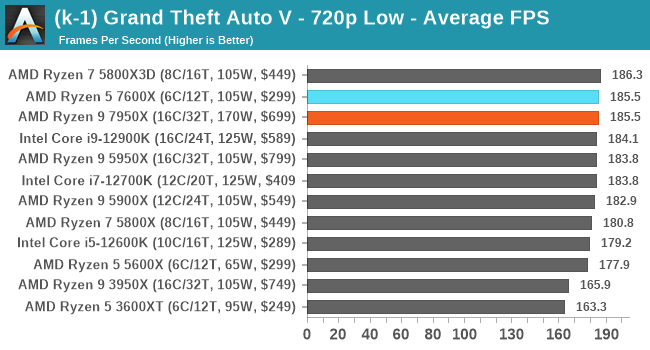
Looking at a more CPU-intensive gaming situation, such as at 720p in Grand Theft Auto V, the Zen 4 cores show their aggression in fighting the Core i9-12900K in terms of framerate. However, they are leapfrogged in this title by the Ryzen 7 5800X3D, which is expected as that processor is great in gaming but average at best in compute scenarios.
As we start to roll out our new CPU suite for 2023, which we're currently testing as we write this review, including some of the most current and latest game titles with more up-to-date graphics cards (Radeon 6950 XT), we will update our review with our findings to see how well the Zen 4 core compares to Zen 3, Zen 2, and Intel's 12th Gen Core. As it stands now, though, AMD's 5nm Zen 4 core hits a home run in compute performance compared to Zen 3 and Alder Lake, but it's more of a stalemate overall in terms of our game testing (so far).
Ryzen 9 7950X at 65 W (ECO Mode): Zen 4 has Superb Efficiency
Regarding power efficiency, AMD claims that their Zen 4 microarchitecture on TSMC's 5 nm node is its most efficient core to date. In light of this, AMD's ECO Mode allows users to adjust the processor limits through its Precision Boost Overdrive 2 settings, which have remained unchanged from the previous generation. The goal of ECO Mode is to restrict overall power with lower CPU VCore and lower current through the CPU socket (AM5) to reduce overall power consumption significantly. This also allows the Ryzen 7000 series to operate at lower temperatures, which is perfect for small form factor systems that can't fit in more aggressive CPU coolers while still benefiting from a large percentile of performance on offer.
AMD's Ryzen 7000 ECO Modes are as follows:
- 170W TDP Base = 105W with ECO Mode enabled
- 105W TDP Base = 65W with ECO Mode enabled
Going one step further than this, users can set their own package power tracking (PPT), thermal design current (TDC), and electrical design current (EDC) values into Ryzen Master or in the Precision Boost Overdrive (PBO) settings section of the firmware. AMD shared with us its recommended settings for 170 W, 105 W, and 65 W. The relevant settings for each of the main (170, 105, 65 W) TDP profiles AMD recommend are as follows:
- 170 W = 230,000 PPT, 160,000 TDC, and 225,000 EDC
- 105 W = 142,000 PPT, 110,000 TDC, and 170,000 EDC
- 65 W = 88,000 PPT, 75,000 TDC, and 150,000 EDC
Using CineBench R23 as our metric in determining how much performance loss there is on the Ryzen 9 7950X from its base TDP of 170 W down to 65 W, we are still seeing high-performance levels on both the single-threaded and multi-threaded tests.
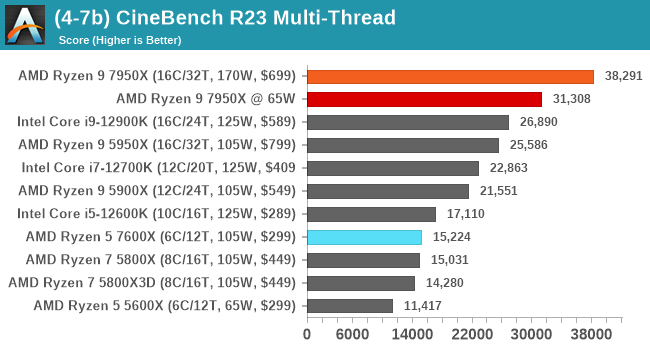
Restricting our Ryzen 9 7950X processor to just 65 W in comparison to leaving power settings untouched, the CineBench R23's multi-threaded test performance is impressive, a score of just over 31K. For comparison, the Intel Core i9-12900K only managed just under 27K at default settings, which shows that even when restricting the power proportionally down to 65 W, there's still plenty of performance available in multi-threaded situations. For reference, restricting the Ryzen 9 7950X to 65W only loses around 18-19% in CB23 MT performance; very impressive.
In the single-threaded test with CineBench R23, we only saw a drop of around 0.3%, which is negligible depending on the workload. Dropping down the overall TDP isn't as harsh on single-threaded workloads as it will be for multi-threaded workloads. ST performance remains intact mainly despite restricting overall power consumption.
The reason we used 65 W as a showcase for Zen 4's efficiency is quite simple. Restricting the power values on the Ryzen 9 7950X by around 61% (170 to 65 W) shows that the Zen 4 core is efficient and that the performance is still good. This is more relevant in small form factor systems where performance is desirable, but high heat output could impact on the longevity and performance of other components through thermal throttling.
Final Words: Zen 4 is now King, Long Live the King
Overall, when comparing AMD's new Zen 4 core to their previous Zen 3 microarchitecture, it's a big win for AMD regarding multi-threaded performance. Through the improvement of many aspects, including the switch to a higher transistor count through TSMC's 5 nm manufacturing process, higher core frequencies including both single and all-core, and the switch to DDR5 from DDR4, all of these make for a double-digit improvement to IPC performance.
| AMD Ryzen 7000 Series Processors | |||||||
| AnandTech | Cores Threads |
Base Freq |
Turbo Freq |
L2 Cache |
L3 Cache |
TDP | MSRP |
| Ryzen 9 7950X | 16C / 32T | 4.5GHz | 5.7GHz | 16 MB | 64 MB | 170 W | $699 |
| Ryzen 9 7900X | 12C / 24T | 4.7GHz | 5.6GHz | 12 MB | 64 MB | 170 W | $549 |
| Ryzen 7 7700X | 8C / 16T | 4.5GHz | 5.4GHz | 8 MB | 32 MB | 105 W | $399 |
| Ryzen 5 7600X | 6C / 12T | 4.7GHz | 5.3GHz | 6 MB | 32 MB | 105 W | $299 |
When it comes to single-threaded and multi-threaded performance, AMD takes comprehensive wins in both elements when it comes to computational workloads across the board. Although Intel's Core i9-12900K is undoubtedly a viable kit for everything, the Ryzen 9 7950X is currently the world's most powerful x86 desktop processor and delivers the performance to back it up. With an MSRP of $699, it's a cheaper insertion point than the Ryzen 9 5950X ($799) by $100, so pricing-wise, it's certainly an improvement for AMD's top-tier processor.
Touching on the Ryzen 5 7600X, this is targeted as more of an affordable processor, with similar performance levels compared to the previous generations of Ryzen 7 5800X. This in itself is an improvement, as it's essentially a 6C/12T Zen 4 processor trading blows with a Zen 3 8C/16T processor. The pricing is even more critical, as the Ryzen 5 7600X has an MSRP of just $299, making it exceptional value for money, especially from the gaming perspective. In contrast, the Ryzen 7 5800X that the 7600X trades blows with had a cost of $449 at launch back in 2020, so AMD is raising the game again in the current economic climate.
AMD has again taken the crown in overall CPU performance, so it's now Intel's turn to see how they respond. While it is expected that Intel will be retaliating in some shape or form, either that be through price cuts to its existing Alder Lake processors or the launch of its upcoming 13th Gen Core series (codenamed Raptor Lake), it has a lot of ground to make up in IPC and compute performance. At the time of writing, the AMD Zen 4 core is powerful and shows good performance efficiency at lower power levels.











205 Comments
View All Comments
emn13 - Monday, September 26, 2022 - link
The geekbench 4 ST results for the 7600x seem very low - is that benchmark result borked, or is there really something weird going on? Replyemn13 - Monday, September 26, 2022 - link
Sorry, I meant the geekbench 4 MT not ST results. The score trails way behind even the 3600xt. ReplySilver5urfer - Monday, September 26, 2022 - link
Good write up.First I would humbly request you to please include older Intel processors in your suite, it will be easier to understand the relative gains for eg the old 9th gen, 10th gen as a reliable place I see things all over on other sites, AT is at-least consistent so would be better if we have a ton of CPUs in one spot. Thanks
Now speaking about this launch.
The IOD is now improved by a huge factor so no more of that IF clock messing with the I/O controller and high voltage on the Zen 3 likes it's all improved so I think the USB fallout issues are fixed on this platform now. Plus the DP2.0 on iGPU is a dead giveaway on RDNA3 with DP2.0 as well.
IMC is also improved looking at it AMD operated with synchronized clocks with DRAM now they can do it without that since IF is now at 2000MHz and the IMC and DRAM are higher at 3000MHz to match the DDR5 data rates. Plus the EXPO is also lower latency, however the MCM design causes the AIDA benchmark to have high latency vs Intel even though Intel is operating at Gear 2 ratio with similar Uncore decoupled. Surprisingly the inter core latencies did not change much, maybe that's one of the key to improving more on AMD side gotta see what they will do for Zen 5.
The CPU clocks are insane, 5GHz on all 16C32T is a huge thing, plus even the 7600X is hitting 5.4GHz. Massive boost from AMD improving their design, plus the TSMC5N High Performance node is too good. However AMD did axed their temps and power. It's a very good move to not castrate the CPU with power limits and clocks now that's out it gets to spread it's wings. But the downside is, unlike Intel i7 series Ryzen 6 also gets hot meaning the budget buyers need to invest money in AIO vs older Zen 3 being fine on Air. That's a negative effect for AMD when they removed the Power Limits like Intel and let these rip to 250W.
Chipset downlink capping at PCIe4.0x4 was the biggest negative I can think of it, because Intel DMI is now 4.0x8 on ADL and RPL, RKL had it at 3.0x8 CML at 3.0x4. AMD is stuck to 4.0x4 from X570. Many will not even care, but it is a disadvantage when you pay top money for X670E they should have given us the PCIe5.0x4, AMD will give that in 2024 with Zen 5 X770 chipset that's my guess.
The ILM backplate engineering is solid that alone and the LGA1718 AM5 longevity itself is a major PLUS for AMD over LGA1700's bending ILM and EOL by 13th gen. Yes the 12th gen is a better purchase given how the Cooling requirement for i7 and i5 is not this high like R6 and R7 and the cheaper board costs plus 13th gen is coming and AMD's platform is new as well you would be a guinea pig. Depends on what people want and how much they can spend and what they want in longevity.
Performance is top notch for 7600X and 7950X absolute sheer dominance but the pricing is higher when you see the % variance vs Zen 3 and Intel 12th gen parts, and added AIO mandatory because they are hot. The gaming performance is as expected not much to see here and the 5800X3D still is a contender there but to me that chip is worthless as it cannot match any processor in high core count workloads. Although 7600X is a champion 6C12T and it beats 12C24T in many things and the 10C20T 10th gen Intel too. IPC is massive in ST and MT workloads as expected. AMD Zen 4 will decimate ARM, Apple has only one thing lol muh efficiency all that BGA baggage, locked down ecosystem is free.
RPSC3 perf at TPU's Red Dead Redemption is weird as I do not see any gains over Intel, given how much of a beast this AVX512 is on Zen 4 with 2x256Bit without AVX offset that too maybe they are not using AVX512. Plus their AMD Zen 3 gauging is also bad because they do not work well vs Intel 9th gen even, I wish you guys cover Dolphin emu, PCSX2, RPCS3 and Switch Emulators.
I think best option is to wait for next year and buy these parts as they will drop, right now no PCIe5.0 SSD in high capacity. no PCIe5.0 GPU even that Nvidia skimped on it. No use of the new platform unless one is running a super damn old CPU and GPU setups.
Shame that OC is totally dead, Zen 3 was hamfisted with its Curve Optimizer and Memory tuning becoming a head ache due to how AGESA was handled and the 1.4v high voltage and lack of documentation. Zen 4 it's even 1.0-1.2v still no OC because AMD's design basically is now pushed to maximum with it's Core TJMax temps and how it works on the basis of Core temperatures over everything else. There's no room here, AIO is saturated with 90C here. Too high heat density on AMD side similar to Intel 11th and 12th gen. Although Intel can go upto 350W and hit all cores at higher vs AMD 250W max. Well OC was on life support, only Intel is basically keeping it alive at this point after 10th gen it became worse and 12th very hot and high heat and now 13th gotta see if that DLVR regulator helps or not.
All in all a good CPU but has some downsides to it. Not much worth for existing 2020 class HW folks at all. Better wait when DDR5 matures even further and more PCIe5.0 becomes prevalent. Reply
Threska - Monday, September 26, 2022 - link
Maybe people will start delidding.https://youtu.be/y_jaS_FZcjI Reply
Silver5urfer - Tuesday, September 27, 2022 - link
That Delid is a direct die, it will 100% ruin the AM5 socket for longevity and the whole CPU too. That guy runs HWBot, ofc he will make a video on his bs delid kits. Nobody should run any CPU completely blowing the IHS off. You will have a ton of issues with that. Water leak, CPU silicon die crack due to Thermodynamics and the pressure differences over the time, Liquid Metal leak. Total bust of Warranty on any parts once that LM drops on your machine game over for $5000 worth rig there.AMD should have done some more improvements and reduced the max TJ Max to say 90 at-least but it's what it is unfortunately (for high temps and cooling requirements) and fortunately (to have super high performance) Reply
Threska - Tuesday, September 27, 2022 - link
There are some in the comments both wondering if lapping would achieve the same and the thicker lid was giving some room for future additions like 3D cache, etc. Replyabufrejoval - Wednesday, September 28, 2022 - link
I'm not sure that PCIe 4.0 "DMI" downlink capping is a hard cap per se by the SoC, but really the result of negotiations with the ASmedia chipset, which can't do better. I'd assume once someone comes up with a PCI 5.0 chipset/switch, there is no reason it won't do PCIe 5.0. It's just a bunch of 4 lanes, that happen to be connected to ASmedia PCIe 4.0 chips on all currrent mainboards.Likewise I don't see why you couldn't add the second chipset/switch to the "NVMe" port of the SoC or any of the bifurcated slots: what you see is motherboard design choices not Ryzen 7000 limitations. That just has 24 PCIe 5.0 lanes to offer in many bundle variants. It's the mainboard that straps all that flexibility to slots and ports.
I don't see that you have to invest into AIO coolers, *unless* you want/need top clocks on all cores. E.g. if your workloads are mixed, e.g. a few threads that profit from top clocks for interactive workloads (including games) and others that are more batch oriented like large compiles or renders, you may get maximum personal value even from an air cooler that only handles 150 Watts.
Because the interactive stuff will rev to 5.crazy clocks on say 4-8 cores, while for the batch stuff you may not wait in front of the screen anyway (or do other stuff while it's chugging in the background). So if it spends 2 extra hours on a job that might take 8 hours on AIO, that may be acceptable if it saves you from putting fluids into your computer.
In a way AMD is now giving you a clear choice: The performance you can obtain from the high-end variants is mostly limited by the amount of cooling you want to provide. And as a side effect it also steers the power consumption: you provide 150 Watts worth of cooling, it won't consume more except for short bursts.
In that regard it's much like a 5800U laptop, that you configure between say 15/28/35 Watts of TDP for distinct working points in terms of power vs. cooling/noise (and battery endurance).
Hopefully AMD will provide integration tools on both Windows and Linux to check/measure/adjust the various power settings at run-time, so you can adjust your machine to your own noise/heat/performance bias, depending on the job it's running. Reply
Dug - Monday, September 26, 2022 - link
"While these comments make sense, ultimately very few users apply memory profiles (either XMP or other) as they require interaction with the BIOS"This is getting so old. Your assumption is incorrect which should be obvious by the millions of articles and youtube videos on building computers. Not to mention your entire article is not even directed to "general public" but to enthusiasts. Otherwise why write out this entire article? Just say you put a cpu in a motherboard and it works. Say it's fast. Article done.
Why not test with Curve Optimizer? Reply
Oxford Guy - Tuesday, September 27, 2022 - link
This text appears again and again for the same reason Galileo was placed under house arrest. Replysocket420 - Monday, September 26, 2022 - link
Could someone, preferably Ryan or Gavin, please elaborate on what this sentence - "the new chip is compliant with Microsoft’s Pluton initiative as well" - actually means? This is the only review I could find that mentions Pluton in conjunction with desktop Zen 4 at all, but merely saying it's "compliant" is a weird way of wording it. Is Pluton on-die and enabled by default in Ryzen 7000 desktop CPUs? Reply